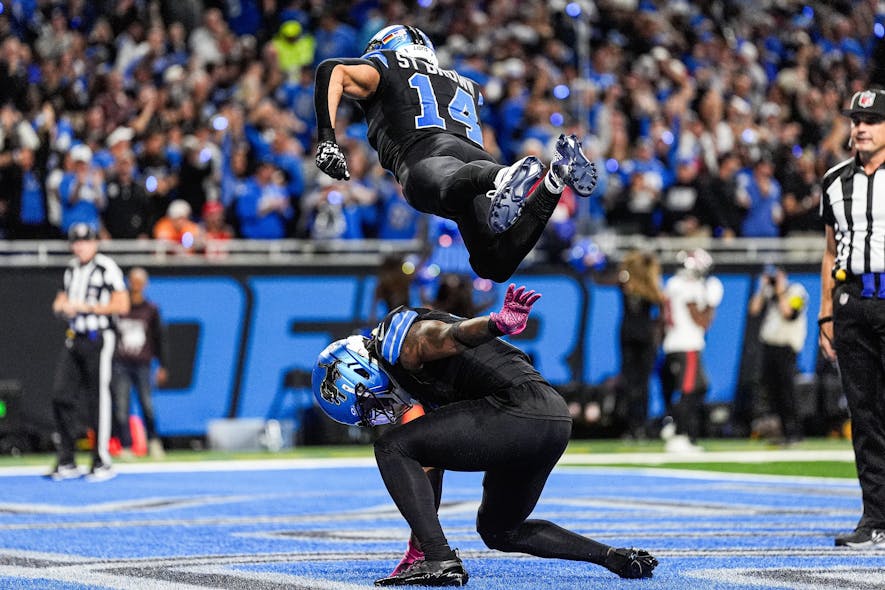Slate Overview
Too Many Good Games?
After a Week 8 slate defined by projected blowouts, Week 9 offers a handful of spots that can turn into true shootouts. Four games on the main slate have totals above 48.5 and are projected to stay close, which creates a fun challenge. We're no longer hunting for one game that can break the slate, but instead figuring out how to build lineups that account for several potential blow-up games.
It may seem obvious, but you'll want to distribute exposure across the games with shootout potential this week to increase your chances of landing on the ones that outperform expectations. Within those high-upside games, target underplayed combinations like secondary receivers, tight ends, or cheaper bring-backs who can capitalize if the game takes off. The idea is to gain leverage while still staying invested in the best game environments.
Balance matters too. Try pairing your primary stack from one high-upside game with a smaller correlated mini-stack from another. If your main stack underwhelms, the mini-stack gives you another way to climb the leaderboard. More importantly, if both games hit, your lineup compounds its ceiling through correlated scoring. It's a structured way to manage your risk without sacrificing tournament-winning potential.
Bottom line: Diversify across good environments, target overlooked player combinations within them, and structure your builds so you're live no matter which of the four or five games goes off.
Top Game Environments
DFS is less about picking players in isolation and more about targeting the games where fantasy scoring can snowball. High totals, fast pace, and exploitable defenses all create environments where multiple players can go off together. Identifying these spots is the foundation for building winning GPP lineups.
Games in bold are lower-total games with the potential for higher-than-expected scoring. Stacking these games at a higher ownership level than the field will add leverage to your lineups if they exceed their implied totals.
- Colts (-3) @ Steelers - O/U 50.5
- 49ers (-2.5) @ Giants - O/U 48.5
- Bears (-2.5) @ Bengals - O/U 52.5
- Chiefs (-2.5) @ Bills - O/U 52.5
- Jaguars (-3) @ Raiders - O/U 44.5
Identifying Common Roster Construction
Understanding what your opponents are most likely to do is just as important as spotting the best plays. Common roster builds form naturally when popular players are combined into a lineup. Recognizing the "chalky" construction helps us anticipate what the majority of rosters we're up against will look like, and allows us to decide the best ways to build differently for leverage without sacrificing ceiling.
QB: In addition to the abundance of high totals making this a fun tournament slate, Friday's news cycle opened up several much-needed value plays. As a result, there may not be a true common roster construction this week, so using player salaries to create leverage provides less of an edge than usual. With that disclaimer out of the way, most entrants will either pay up to Patrick Mahomes II ($7,100) or down to Caleb Williams ($5,700) or Jaxson Dart ($5,200), with very little in between. Chalky builds will diverge from there depending on the quarterback.
RB: Tyrone Tracy Jr. ($5,100) began the week mispriced relative to his projected workload with Cam Skattebo out of the lineup for the Giants. Then we got Friday's practice reports, and he got some company. Kyle Monangai ($4,600), TreVeyon Henderson ($4,900), and Kareem Hunt ($4,700) all joined Tracy as clear backups who've been thrust into starting roles. We should (justifiably) expect Monangai in as many as 75% of GPP lineups, depending on the stakes. Rosters with Dart at quarterback can now get up to Jonathan Taylor's exorbitant $9,800 salary, but it remains to be seen if they'll try. Christian McCaffrey ($8,800) will be the more popular RB1. He draws a matchup against the Giants, who allow the league's highest rushing EPA per play. Regardless of the quarterback, we'll most frequently be looking at two of the above injury fill-ins in our opponents' RB2 and Flex spots.
WR: Rostering a pair of cheap running backs will make it easy for the field to fit Ja'Marr Chase ($8,400) in alongside an expensive McCaffrey. Those leery of Joe Flacco's sprained AC joint tanking Chase's value with an in-game aggravation may opt for a returning Puka Nacua ($8,500) instead. Paying up to Mahomes will normally require two cheaper wide receivers. Chimere Dike ($3,900) is the top candidate after he posted back-to-back solid games in the absence of Calvin Ridley. WR3 punt options in Mahomes builds include Jauan Jennings ($4,300) and Olamide Zaccheaus ($3,300), who should benefit from the absence of Luther Burden III. Dart rosters will have enough room to get to Ladd McConkey ($6,000) at WR2 alongside Chase/Nacua and Dike.
TE: Count on spending in the $5K range. George Kittle ($4,800) got back in our good graces with a touchdown last week. He profiles as a top point-per-dollar play and an affordable piece of what looks like the most heavily stacked game on the slate. Brock Bowers ($5,000) is fully healthy for the first time since Week 1 and costs $1,500 less than he did entering the season. Kittle, Bowers, Travis Kelce ($4,700), Oronde Gadsden ($5,300), Tyler Warren ($5,500), and Tucker Kraft ($5,700) are all in the same general price range and should cannibalize each other's popularity.
Flipping the Common Build: Three-running back lineups with one expensive and two cheap backs are what we're looking to beat. With four potential shootouts to choose from and plenty of value on the board, there is no shortage of ways to build differently. Balanced lineups that only include one cheap running back, top-heavy running back lineups with two high-end plays, and two-tight-end lineups are options the field is less likely to try this week.

